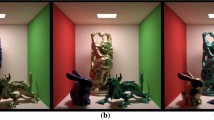Abstract
When rendering the 3D graphics object in the computer vision and graphics fields, the parameter values, such as the surface roughness, refractive index, and light absorption are used for modeling realistic light scattering rendering behavior of a material. Most of these values were usually obtained from different literature or online sources. In general, a specific measuring tool is needed when acquiring the measurement, but, what if we could use an alternative method of measuring when the tools are not available? The idea is to use the light scattering model to estimate the parameter measurement values of material by doing the inverse rendering of the capture polarization image of the object’s light scattering. In this paper, we investigate whether we can estimate four different measurements, using ARLLS model. We captured the object’s degree of polarization (DOP) to be fitted and compare with the model to investigate the relationship between the two by doing the correlation test between the object measurement DOP and the model parameters to see whether the estimations are in agreement with each other (e.g. by reference or by the practical characteristics of the object). Furthermore, the test will be conducted using materials with varying degree of properties (e.g. very rough surface; highly chromatic).
Access this chapter
Tax calculation will be finalised at checkout
Purchases are for personal use only
Preview
Unable to display preview. Download preview PDF.
Similar content being viewed by others
References
Montes, R., & Urea, C. (2012). An overview of BRDF models. University of Grenada, Technical Report LSI-2012, 1.
Chen, C. H. (2015). Handbook of pattern recognition and computer vision. World Scientific.
Wynn, C. (2000). An introduction to BRDF-based lighting. Nvidia Corporation.
Thompson, W., Fleming, R., Creem-Regehr, S., & Stefanucci, J. K. (2016). Visual perception from a computer graphics perspective. AK Peters/CRC Press.
Kurt, M., & Edwards, D. (2009). A survey of BRDF models for computer graphics. ACM SIGGRAPH Computer Graphics, 43(2), 4.
Wolff, L. B. (1994). Diffuse-reflectance model for smooth dielectric surfaces. JOSA A, 11(11), 2956-2968.
Ragheb, H., & Hancock, E. R. (2006). Testing new variants of the Beckmann Kirchhoff model against radiance data. Computer Vision and Image Understanding, 102(2), 145-168.
Guarnera, D., Guarnera, G. C., Ghosh, A., Denk, C., & Glencross, M. (2016, May). BRDF representation and acquisition. In Computer Graphics Forum (Vol. 35, No. 2, pp. 625-650).
Ragheb, H., & Hancock, E. R. (2007). The modified Beckmann Kirchhoff scattering theory for rough surface analysis. Pattern Recognition, 40(7), 2004-2020.
Ragheb, Hossein, and Edwin R. Hancock. “A light scattering model for layered dielectrics with rough surface boundaries.” International Journal of Computer Vision 79.2 (2008): 179-207.
Dahlan, Hadi A., and Edwin R. Hancock. “Absorptive scattering model for rough laminar surfaces.” Pattern Recognition (ICPR), 2016 23rd International Conference on. IEEE, 2016.
Konnen, G. P., & Knnen, G. P. (1985). Polarized light in nature. CUP Archive.
Barron, L. D. (2009). Molecular light scattering and optical activity. Cambridge University Press.
Perez, J. J. G., & Ossikovski, R. (2016). Polarized light and the Mueller matrix approach. CRC press.
Kerker, M. (2016). The Scattering of Light and Other Electromagnetic Radiation. Elsevier.
Goldstein, D. H. (2017). Polarized Light. CRC Press.
Bohren, C. F., & Huffman, D. R. (2008). Absorption and scattering of light by small particles. John Wiley & Sons.
Zhang, L., & Hancock, E. R. (2012, November). A comprehensive polarisation model for surface orientation recovery. In Proceedings of the 21st International Conference on Pattern Recognition (ICPR2012) (pp. 3791-3794). IEEE.
Ma, Wan-Chun, et al. “Rapid acquisition of specular and diffuse normal maps from polarized spherical gradient illumination.” Proceedings of the 18th Eurographics conference on Rendering Techniques. Eurographics Association, 2007.
Dutta, Abhishek. “Face Shape and Reflectance Acquisition using a Multispectral Light Stage.” Diss. University of York, 2010.
Jensen, J. R. (2009). Remote sensing of the environment: An earth resource perspective 2/e. Pearson Education India.
Lillesand, T., Kiefer, R. W., & Chipman, J. (2014). Remote sensing and image interpretation. John Wiley & Sons.
Govaerts, Y. M., Jacquemoud, S., Verstraete, M. M., & Ustin, S. L. (1996). Three-dimensional radiation transfer modeling in a dicotyledon leaf. Applied Optics, 35(33), 6585-6598.
Stimson, H. C., Breshears, D. D., Ustin, S. L., & Kefauver, S. C. (2005). Spectral sensing of foliar water conditions in two co-occurring conifer species: Pinus edulis and Juniperus monosperma. Remote Sensing of Environment, 96(1), 108-118.
Zhang, L., & Hancock, E. R. (2013). Robust estimation of shape and polarisation using blind source separation. Pattern Recognition Letters, 34(8), 856-862.
Atkinson, G. A., & Hancock, E. R. (2006). Recovery of surface orientation from diffuse polarization. IEEE transactions on image processing, 15(6), 1653-1664.
McPherson, A. T., & Cummings, A. D. (1935). Refractive index of rubber. Rubber Chemistry and Technology, 8(3), 421-429.
Mikhail Polyanskiy. RefractiveIndex.INFO - Refractive index database. https://refractiveindex.info, 2018. [Online; accessed March 26, 2018].
Index of Refraction. http://hyperphysics.phy-astr.gsu.edu/hbase/Tables/indrf.html, 2018. [Online; accessed March 26, 2018].
Mukherjee, S. (2013). Physical Properties of Clay and Soil Mechanics. In The Science of Clays (pp. 54-68). Springer, Dordrecht.
Perry, D. R., Appleyard, H. M., Cartridge, G., Cobb, P. G. W., Coop, G. E., Lomas, B., … & Farnfield, C. A. (1985). Identification of textile materials.
Woolley, J. T. (1971). Reflectance and transmittance of light by leaves. Plant physiology, 47(5), 656-662.
Forest B. H. Brown. (1920). The Refraction of Light in Plant Tissues. Bulletin of the Torrey Botanical Club, 47(6), 243-260. https://doi.org/10.2307/2480396
Gausman, H. W., Allen, W. A., & Escobar, D. E. (1974). Refractive index of plant cell walls. Applied optics, 13(1), 109-111.
Author information
Authors and Affiliations
Corresponding author
Editor information
Editors and Affiliations
Rights and permissions
Copyright information
© 2020 Springer Nature Singapore Pte Ltd.
About this paper
Cite this paper
Dahlan, H.A., Hancock, E.R., Smith, W.A.P. (2020). Estimating Material Parameters Using Light Scattering Model and Polarization. In: Alfred, R., Lim, Y., Haviluddin, H., On, C. (eds) Computational Science and Technology. Lecture Notes in Electrical Engineering, vol 603. Springer, Singapore. https://doi.org/10.1007/978-981-15-0058-9_39
Download citation
DOI: https://doi.org/10.1007/978-981-15-0058-9_39
Publisher Name: Springer, Singapore
Print ISBN: 978-981-15-0057-2
Online ISBN: 978-981-15-0058-9
eBook Packages: EngineeringEngineering (R0)




